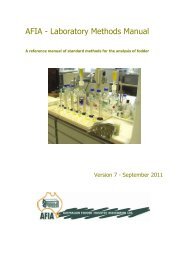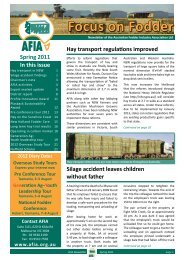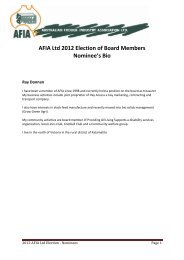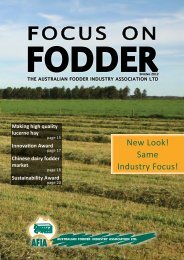NEWSLETTER - Australian Fodder Industry Association
NEWSLETTER - Australian Fodder Industry Association
NEWSLETTER - Australian Fodder Industry Association
Create successful ePaper yourself
Turn your PDF publications into a flip-book with our unique Google optimized e-Paper software.
situation is bleak. Wyangala Dam has had no<br />
inflow and only 40 per cent of the carryover<br />
is available for irrigation as part of the<br />
drought contingency plan.<br />
While very little hay is trading, Gary puts<br />
the market for prime lucerne hay at around<br />
$290-330 / tonne for big bales and around<br />
$10-12 per bale for small bales. Second<br />
grade lucerne is nominally trading at<br />
between $200 and $290. Prime, or export<br />
quality, cereal / oaten hay is selling for<br />
around $160-170 / tonne (all prices are plus<br />
GST).<br />
Continuing with the theme of dry and patchy<br />
conditions, Philip Hanna of<br />
Berrigan on the border<br />
between NSW and Victoria<br />
says the crops in his area are<br />
‘real bad’ and crops are<br />
starting to ‘go back into the<br />
ground’. Having said this,<br />
Phillip says areas to the north<br />
and the south received good<br />
rain during July.<br />
From a hay market perspective,<br />
Philip says that before the rain,<br />
about a month ago, you<br />
couldn’t have enough hay there<br />
was so much interest, but since<br />
the rain the market has ‘died in<br />
the butt’. Before the rain hay<br />
was selling for $220-250 /<br />
tonne for lucerne hay and<br />
around $180 for oaten hay<br />
(prices are plus GST). But<br />
now, very little is selling.<br />
As with other areas, access to<br />
irrigation water in the Berrigan<br />
area is limiting hay production.<br />
The Hume Weir is around 24<br />
per cent full and there is zero<br />
irrigation allocation.<br />
Along the river and up the<br />
Hume Freeway from Philip’s,<br />
Bill Fife, transporter,<br />
wholesaler and retailer of hay in the<br />
Goulburn area, confirms he too is travelling<br />
to buy hay, but says there is good quality and<br />
good volumes if you are willing to travel.<br />
In August Bill said he was buying cereal hay<br />
in northern Victoria for around $120-140 /<br />
tonne and chaff quality lucerne hay for<br />
around $220-230 / tonne, but this is more<br />
difficult to source.<br />
As a transporter, Bill noted that fuel is now a<br />
much bigger part of his costs. Previously, as<br />
a rule of thumb, fuel was about a quarter of<br />
total costs, but now it is more like a third.<br />
AFIA Newsletter September 2006 6







